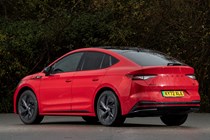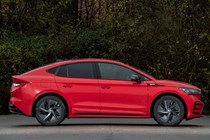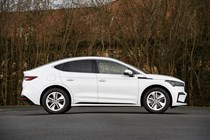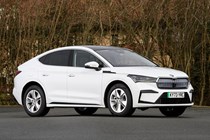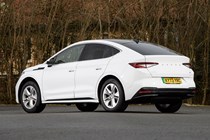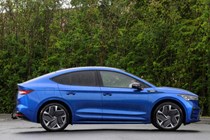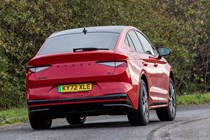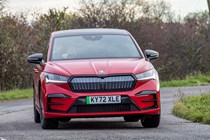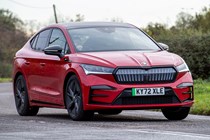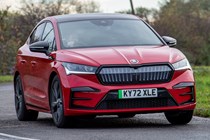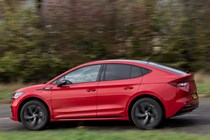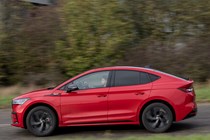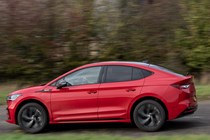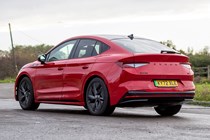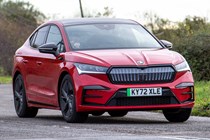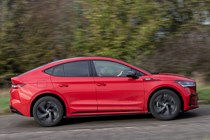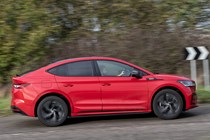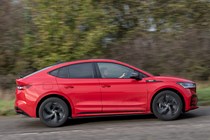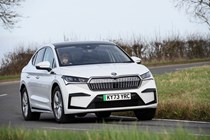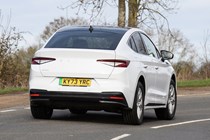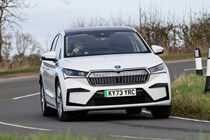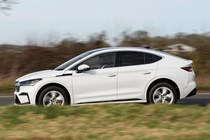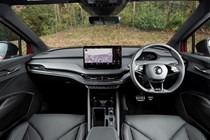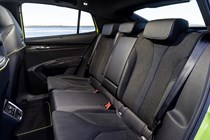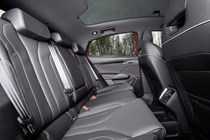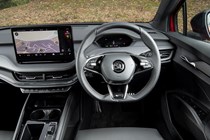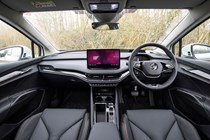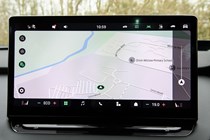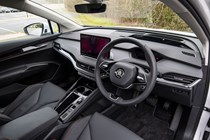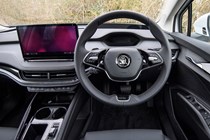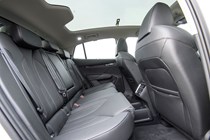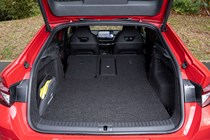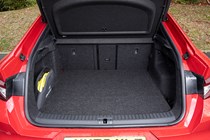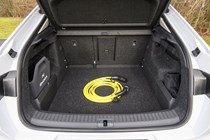
Skoda Enyaq Coupe long-term test
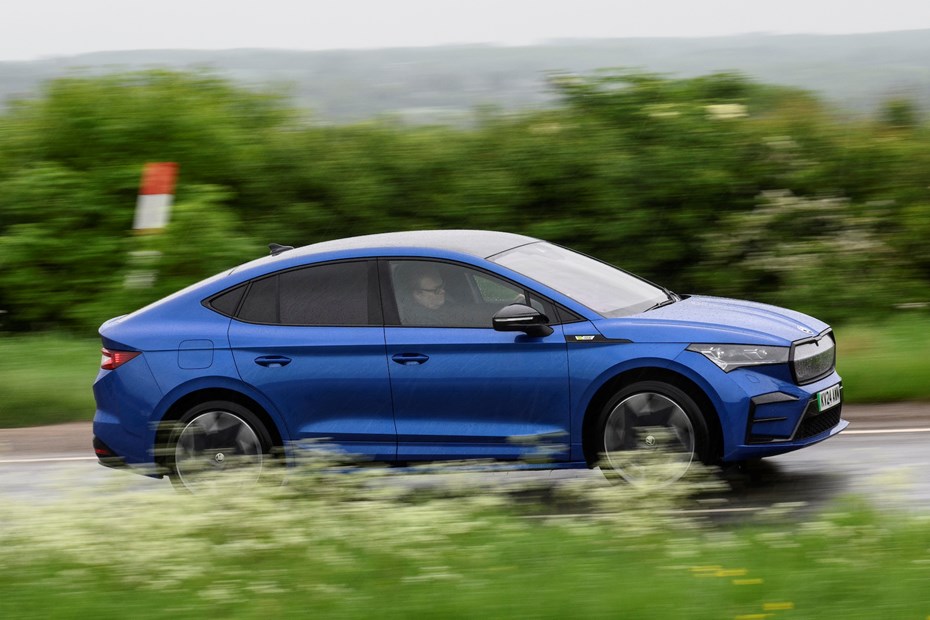
Parkers Editor, Keith Adams (below), is running a Skoda Enyaq vRS on a long-term basis to see if a long-distance driver can really live with an electric car. This car has been upgraded since he ran his last one, so he’s also comparing old and new to see where the progress has been made since 2021.
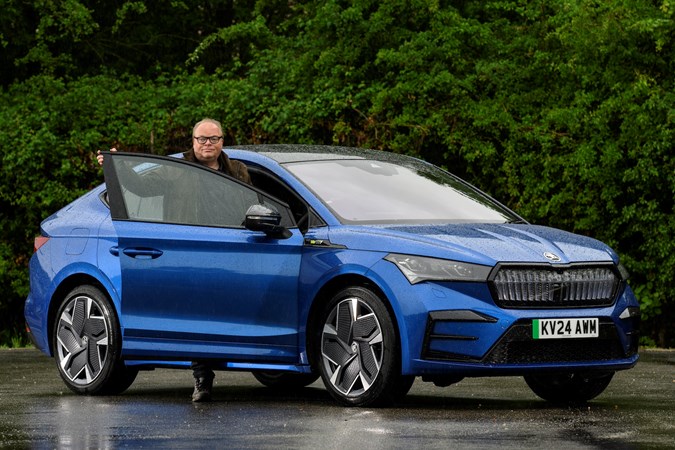
Update 1: Welcome
Introducing the Skoda Enyaq Coupe vRS
Welcome to the extended long-term review of the Skoda Enyaq Coupe vRS. If you’re a regular reader you’ll already know that we really rate this car – it’s an EV that’s easy to live with, practical, nicely finished inside and has a really usable amount of battery range in the more expensive versions. The regular SUV version was a convincing Car of The Year winner for us, and the Coupe is more of the same.
The Coupe bodystyle followed the SUV in 2022, and was offered with a range of models that largely mirrored the SUV version. However, the range was lightly modified for 2024, with a number of small tweaks to keep it competitive with a raft of fresher new rivals. Befitting its more exclusive status, the Enyaq Coupe’s model range been realigned, so it’s now only available in its largest battery capacity of 82kWh.
We’ve gone for vRS, which has the same 82kWh battery, but has a two-motor set-up that delivers a thumping 340hp for a maximum claimed range of 340 miles and 0-62mph time of 5.5 seconds. Will it match those claims? We’ll get back to that in a later update. It feels a bit deja vu mainly because I ran an Enyaq for eight months throughout 2021 and 2022, and really enjoyed it. Check out the Skoda Enyaq Coupe specs page on Parkers for the entire range.
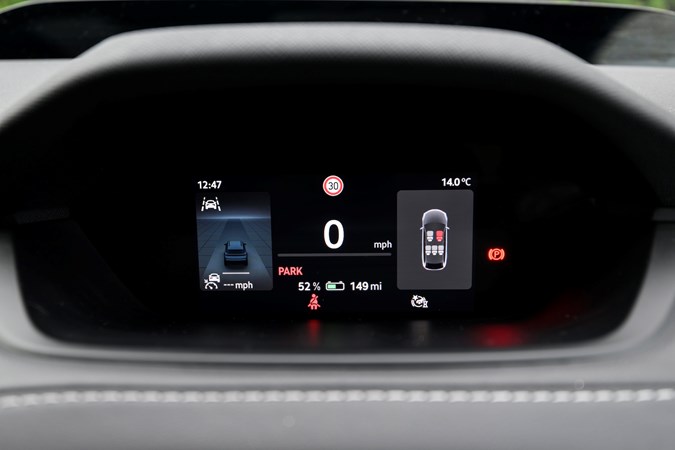
What you get with an Enyaq Coupe vRS
As standard, our Enyaq vRS will cost you £54,820 (at the time of writing), which puts it up against some very interesting rivals. Being a vRS it’s quick enough to entertain and is equipped well enough to make you feel you’re justified in laying out more than £50k for it. It doesn’t come with everything, and you’d need to buy a Laurin & Klement version, but this one is more heavily-specced than is traditional for a vRS.
Here are the 10 stand-out features you get as standard:
- Adaptive cruise control with traffic jam assist
- Drive mode select
- Front and rear parking sensors
- Full LED Matrix beam headlights with variable light distribution
- Heated front seats
- Infotainment Online (three years) with Proactive Services (10 years) +
Remote Access (one year) - Keyless entry and start/stop system advanced with walk away locking
- Panoramic glass roof
- Traffic sign recognition
- Wireless charging
In addition, we’ve picked £5,150-worth of optional extras, which I’ll go through in the next update. There’s a number of option packs available for the Enyaq, and to get the car in the spec you really want, be prepared to spend some time on Skoda’s configurator.
Although it’s the sporty version, I’m expecting a decent driving range. This will be a car that can pound the motorway on my 190-mile commute to the office without stopping a recharge. Skoda claims up to 340 miles for this car, and I’ve found it’ll do 280 miles at the 70mph M6 schlep. That’s more than enough.
Over the coming months, I’ll get back into Enyaq driving and regularly using Britain’s motorways to see if it really is possible to take an electric car on as a no-compromise replacement for your family petrol or diesel. I can’t wait – I’m a big fan already – and I’m looking forward to performing a really detailed long-term test.
Update 2: Cabin, equipment and options
What’s the Enyaq vRS like to spend time in?
Long story short – the Enyaq’s interior is nicely designed, easy to live with, looks good and is quite friendly. And overall, I like it a lot although I wish it were a little more comfortable.
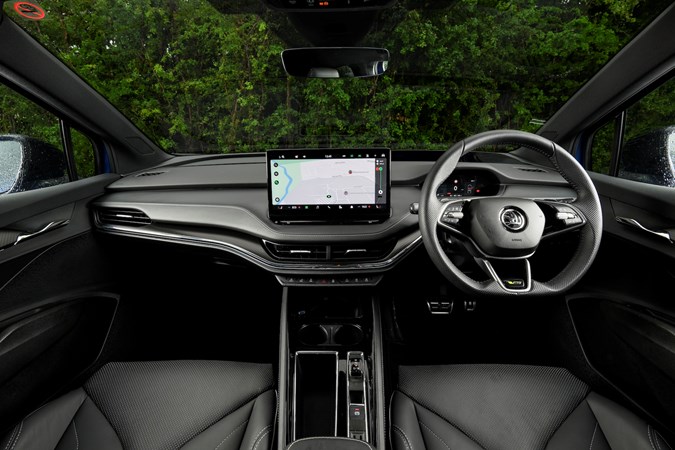
The Enyaq Coupe vRS as it landed on my drive is a few quid short of £60k, so although I know how good it is, it also needs to feel prerry special compared with rivals such as the Kia EV6, Tesla Model Y or Ford Mustang Mach-E. There are some newer and visually more exciting options, such as the Volvo EX30 and Renault Scenic E-Tech, but they’re actually rather cheaper. What to do…
So, this isn’t a value for money choice these days. Its closest rival is the Volkswagen ID.5 GTX, which offers the same technical package with a boldly styled exterior and more challenging interior. Don’t get me wrong, the vRS isn’t actually a shrinking violet, especially in Race Blue Metallic and riding on 21-inch wheels, but I’m not convinced it has that certain something I’d expect in a £60k car. I suspect I might think differently if it were an L&K in one of its plusher trim packages.
Optional extras: sorting the wheat from the chaff
I touched on the generous standard equipment of the Enyaq vRS in my last update, but the optional extra fitted make for interesting reading. Here’s what’s been added:
21-inch Vision Anthracite Alloys: £620
Not worth it… The car looks over-wheeled, almost toy-like, and I doubt they do anything for the already firm ride quality.
Race Blue Metallic paint: £660
Maybe worth it… If you want to stand out from the crowd, this is a great colour to choose. It’s probably better than the over-the-top Dragon Green, also offered.
Electrically-retractable tow bar: £815
Worth it… If you’re looking to exploit the Enyaq’s 2,650kg towing capacity, this is the towbar to have, as it’s such a neat installation.
Heat pump: £1,025
Not worth it… Not because you don’t get efficiency gains, but because at this price, a heat pump really should be standard.
Advance package: £2,035
Worth it: You get a head-up display, heated rear seats, a heated windscreen and a Canton sound system – and although you won’t see this back at re-sale, you’ll appreciate these features.
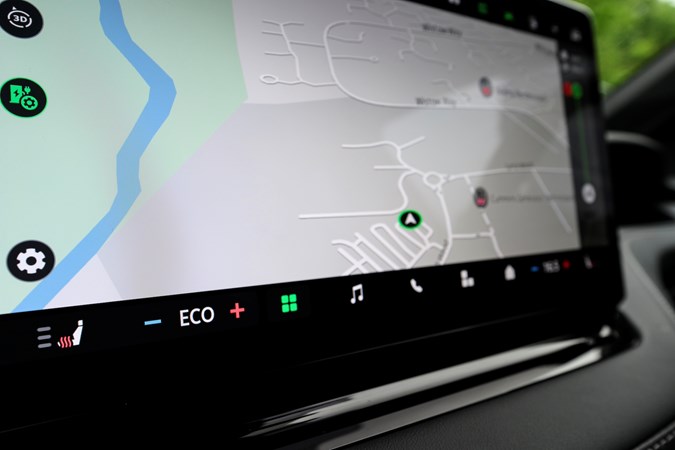
Infotainment and tech
You get a large, centrally-mounted 13.0-inch infotainment display with built-in 3D navigation, and the latest iteration of Skoda’s user-friendly operating system. The size and positioning make it easy to operate, and voice control ‘Hey Laura’ works unusually well.
It’s very clear, sharp and easy to get your head round, and the only criticisms I have of it is that it’s not angled towards the driver, looks awful when covered in fingerprints and it’s mounted so high it means the fresh air vents are pushed lower down into the cabin. There’s decent built-in route planning, too, with the factory sat-nav making sensible and useful charging suggestions on a long journey.
Because most of the car’s features are handled on this screen, and the driver’s instrument panel is so small, the interior looks basic (see point above), but the good news is that it integrates with wireless Apple CarPlay and Android Auto extremely well. The Skoda Connect services that come with it seem quite basic (I can check on battery status and pre-heat the cabin), but I can’t remotely unlock it or do some of the stuff that Tesla owners take for granted. Shame.
Update 3: Range and charging
How far does it go on a charge and how much does it cost?
Long story short – the Enyaq hasn’t matched the claimed 340-mile range, but it’s still very capable of long distances, as I proved on a recent trip to Ireland.
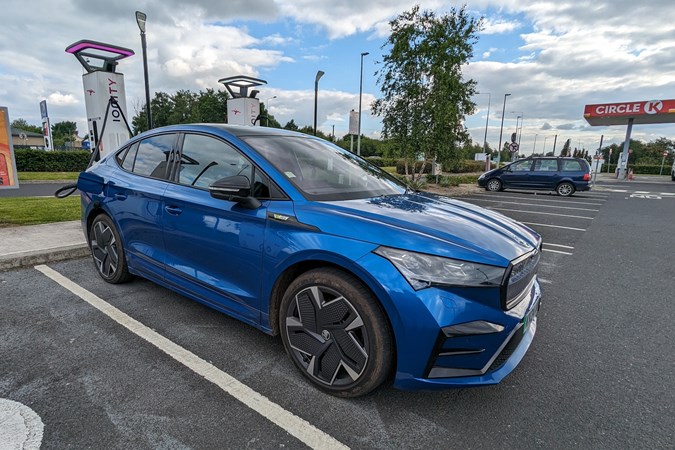
Here I am, 4,000 miles in and it’s time to talk charging. The good news is that I’m running it from the position of having a Wallbox at home connected to Octopus Intelligent charging and access to charging at the office. Despite that, I do make liberal use of public rapid chargers, and so far have found all options to be painless. And in the former case, extremely cost effective.
Although early 2024 has been dismal for weather, at least the temperatures have been quite moderate, which is good for the range and efficiency of the battery pack. I expected some impressively long and uninterrupted drives in it. And so it proved, with an average of 3.5 miles per kWh resulting in a very easy 250+ miles on the daily commute at motorway speeds. The best I have seen is 280 miles with 20 left in the ‘tank’.
After a full recharge, the displayed range is estimated from your last time spent in the car, which generally proved reliable – and what I’ve been finding is that it’s reporting between 260 and 280 miles depending on where I’ve been taking it. The lower figure represents time spent on the motorway, with the higher estimate reflecting lower-speed A- and B-road commuting.
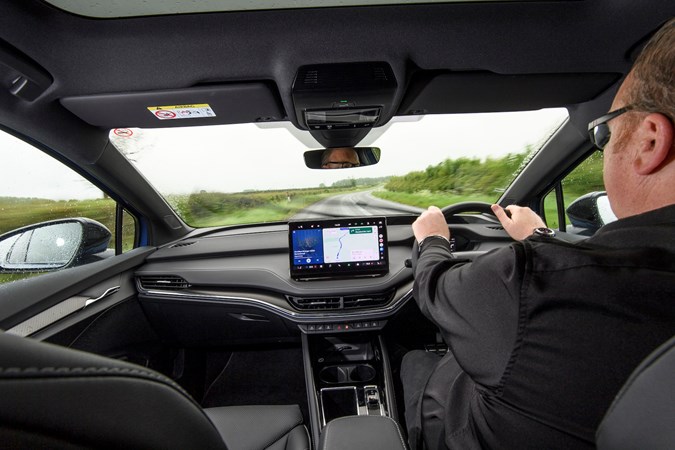
I’m finding it ridiculously easy to live with, too, although to be fair, it’s far from being my first electric car. But public charging is getting better by the day, with Gridserve and Instavolt being noteworthy for providing user-friendly tap-and-go contactless charging. Good, because I hate having a suite of apps on my phone.
I recently took a trip to the western coast of the Republic of Ireland, and found the experience refreshingly stress-free. From home in Lancashire, I hot-footed it down to the Hollyhead ferry, crossed over, and recharged for 30 minutes (going from 30-80%) at an Ionity station 50 miles west of Dublin (above). From there, I drove to my hotel in Tipperary (another 170 miles), and plugged it in their destination charger. No worries.
It was the same for the journey back, although I noticed that Irish Ferries has Pod Points so might make use of those next time I am there. My destination was Kerry Airport and it was great to see CFO Basil Sheerin (left) and CEO John Mulherne (right) using a Skoda Enyaq iV as the site’s support and response vehicle – perfect as it has on-site charging.
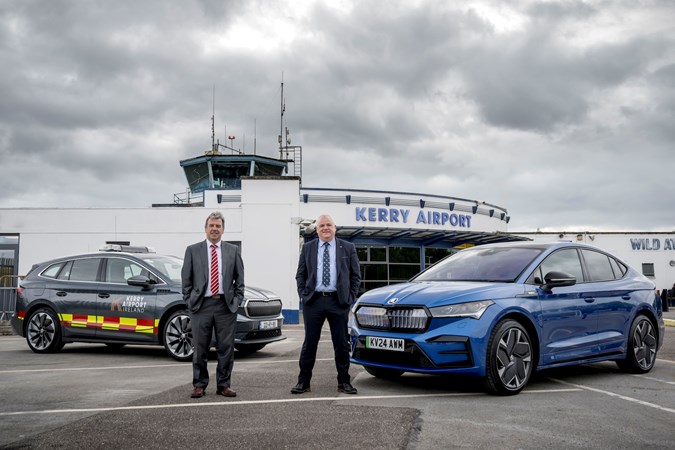
How much does it cost?
As mentioned before, I am hooked up to an Octopus intelligent Charging package. What this means is I leave my car plugged in and the Wallbox only charges during off-peak times to take advantage of the lowest-priced electricity. According to my Wallbox app, I pay between £10.50 and £14.00 for a top-up back to 100%, which represents pretty decent value for money.
Public charging opens you up to higher cost but you gain loads in speed and convenience. I tend to top-up rather than fill up, and that means I’m generally putting in £15-20. The most expensive recharges have been Ionity in Ireland, which worked out at £35 a pop. I’m not unhappy with that.
Update 4: Performance and handling
How well does it go and have those miles been enjoyable?
Long story short – the Enyaq not be the fastest family-sized EV on the market, but it’s more than quick enough for Keith. And all that power and performance is backed up with safe, agile handling.
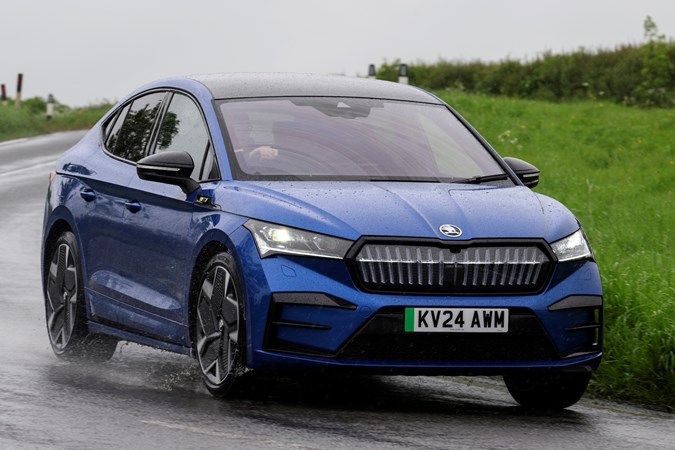
This might feel a little like a case of deja vu for regular site readers, but the Enyaq vRS feels solid, planted and usefully rapid. Skoda is fully across its brand values, and appreciates that the driver is looking for significant overtaking punch, effective straightline speed and a quick getaway from the lights. The 0-62mph time of 5.5 seconds feels, if anything, a little conservative – but is left behind by upstart rivals such as the Volvo EX30 and MG4 XPower.
I have to say that I really like the way it goes. If you’re stuck behind someone ambling at 40mph on a National Speed Limit section of A-road, getting past them is a cinch – just press and go. Here, the Enyaq lifts its skirts and flies by. The smoothness of the power delivery is what makes the Enyaq iV, though, because you can minutely adjust the level of acceleration to your needs and enjoy a seamless surge forwards.
In order to offer handling that lives up to this performance, Skoda has saddled the Enyaq vRS with quite a stiff ride. I’ll come back to that in a later report, but let’s just say that on the UK’s typically rubbish B-roads, the ride can be so firm and unsettled as to draw negative comments from passengers. This is especially the case in the rear – with a couple of of passengers even complaining of car sickness. I hope it’s not my driving.
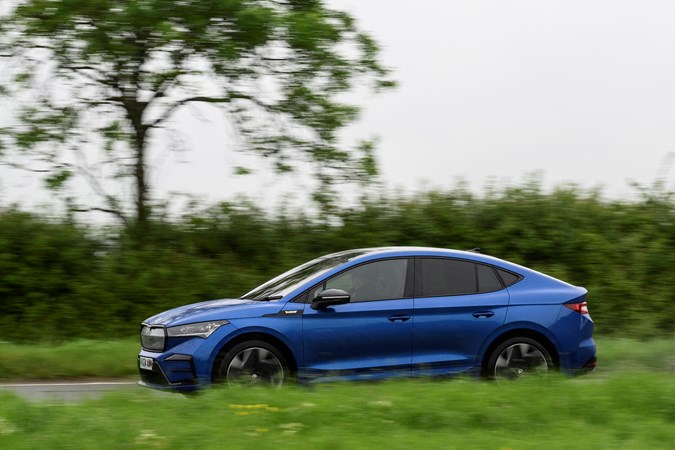
But I can live with this given the sheer amount of grip and safety it offers. Iin bends it’s agile and secure, which is something of an achievement for a car that weighs this much (1,890kg). A recent emergency manoeuvre to avoid a broken down car in the middle of a blind bet bears testament to how good this car’s active safety is.
As I said in my previous Enyaq long-term test, ‘it’s not exciting, but is that really a priority in a family SUV? On the motorway, it’s especially good – both quiet and stable, and capable of eating up miles with no real downsides.’ I stand by that here, even though it has vRS badging and is the sporty model in the model range.
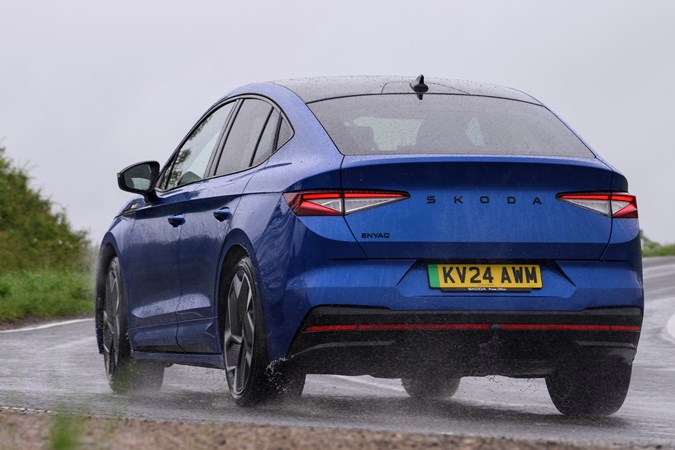
Update 5: Reliability, 5,000 miles on
All new cars are reliable, yes?
Long story short – the Enyaq is the first modern car Keith’s needed to call out the AA to after being left stranded. No complaints about the service, mind…
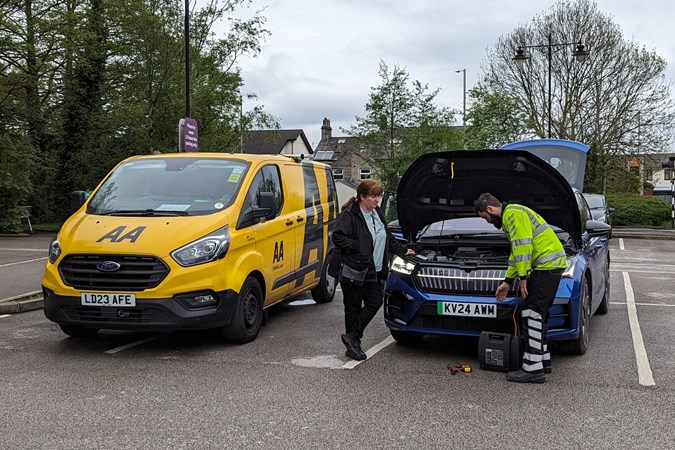
It doesn’t happen with new cars, so when we suffer from a failure to proceed, it comes as a genuine surprise. I must admit that my faith in the Enyaq was shaken a week after I picked it up from new, when the charger flap refused to open on the keyfob, leaving me unable to plug it in. For many people, that might have been a showstopper, as there was just 25 miles of range in it when it happened – but luckily I had another car to go out in.
When I returned, I did a little Googling, and it transpired that a sticky charger flap is not uncommon on Volkswagen ID-related cars, and the solution is to rapidly lock and unlock the car a few times. I did the same, and the flap duly unlocked accompanied by a sense of relief from me. However, owners report that eventually this ‘hack’ will stop being effective, and warranty repair work will be needed. We’ll see.
The second issue was more serious, and should be officially considered a breakdown. Following an afternoon shopping, I returned to the Enyaq, jumped in, only to find that I didn’t get the usual start-up chime. Selecting drive did nothing, and instead I had a set of warning lights on the dash glowering angrily at me. Oh, no – a flat battery. But not the battery pack, but instead my 12V battery.
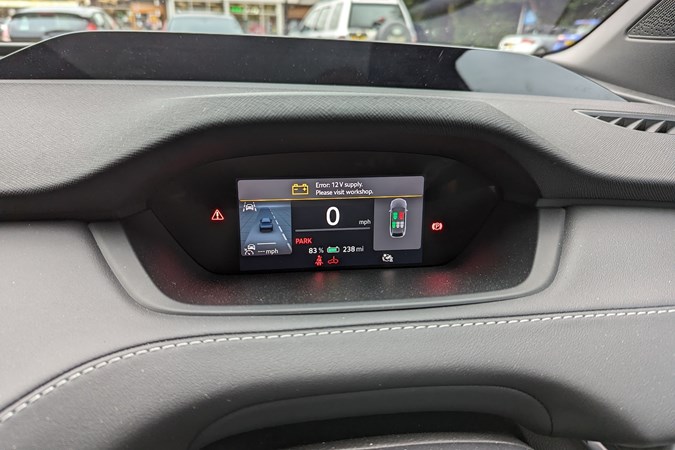
At this point, I just called Skoda Assist. I don’t carry jump leads with me, so would need the AA to come out and give me a jump start. The operator was very friendly and said a technician would be with me within 45 minutes – just time to nip next door and drink a quick coffee. As it happened, the patrolman turned up in 20, and called me back to the car.
As expected, he attached his booster pack to the 12V battery under the bonnet, and jumped the Enyaq into life. I asked him if this were a common fault with these cars, to which he responded by smiling and nodding. Yes, he said – usually Volkswagen ID-models, and it’s a software fault. After that, he smiled and waved me on my way.
Taking no chances, I drove home and plugged it into my battery charger, just to get things up to 100%. The fault has shown no signs of returning, but I do now carry jumpleads in the car – just like I do with all my classics.
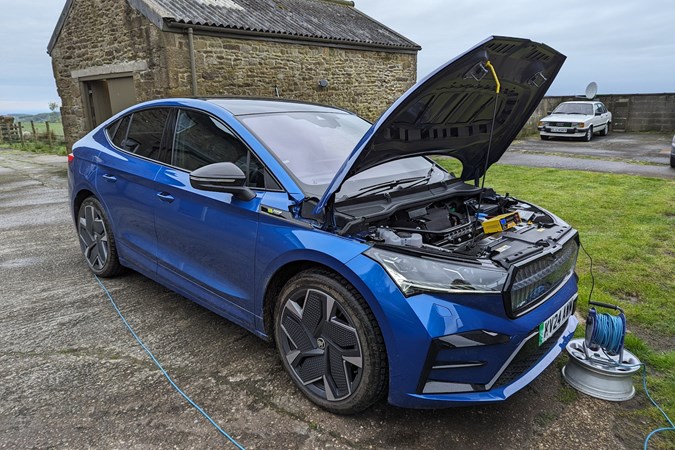
Update 6: All the practicality, 9,000 miles on?
Earlier wobbles have not returned
Long story short – the Enyaq hasn’t put a foot wrong since its little hissy fit earlier. So, has it been perfectly accommodating to live with? Yes.
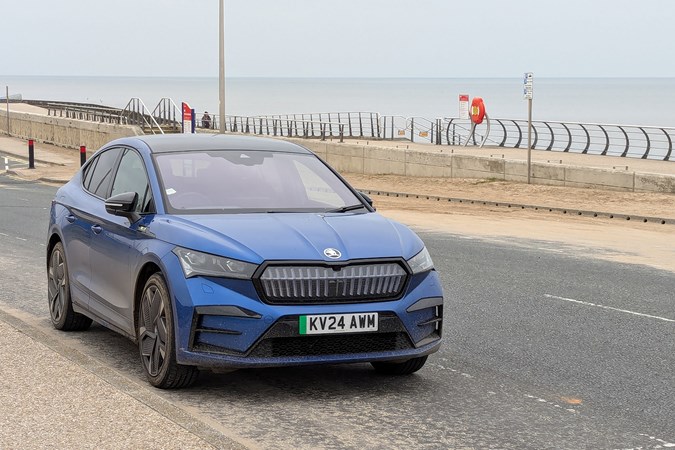
In case you hadn’t noticed, my Skoda Enyaq vRS sports the rather natty Coupe bodystyle. It’s a sign of the times that the term ‘Skoda Coupe’ would have once triggered memories of the excellent 130R pounding its way to clas wins on the Lombard RAC Rally, but today we’re looking at an SUV with a more rakish roofline. That’s no bad thing because unlike those two-doors of days gone by, a modern Coupe is also a very effective family car.
Have I felt a loss in terms of practicality over the standard Enyaq? Not really. The boot space totals 570 litres (seats up), which is only 15 litres less than you get in the SUV. More importantly, I love the large opening you get with the Coupe, which has helped me cram all manner of stuff into it. It’s also the same story with rear seating – my son, who is 6ft 3in, hasn’t once complained about the headroom. Just the poor ride…
In other news, the previous bouts of sulkiness have not returned. The Enyaq Coupe is once again a reliable, dependable family car that can be used without the need to call the AA. It’s not perfect, though. The infotainment screen keeps glitching, by switching itself off for a second at a time every once in a while, and the interior has developed a couple of annoying rattles – one from the glovebox, and one in the rear.
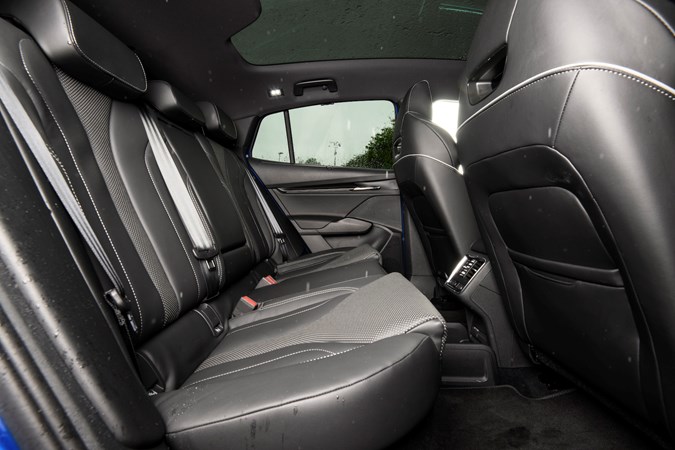
Verdict: What’s it like to live with?
You already know the answer to that. I really rate the Enyaq, and have always called it out as a brilliant family car that just happens to be easy to live with. There have been a couple of unexpected reliability wobbles and an interior rattle to do its best to undermine the car’s quality feel, but overall it’s been hard to fault and easy to like.
The vRS performance is more than enough to provide safe overtaking, and enough punch to keep up with the flow, while its effortless motorway demeanor makes it a great car for long distance trips. The firm ride is a disappointment (even in the context of this being a sporting car) and has rather taken the shine off it as something to drive in a rural setting on rough roads, but the upside is that the handling is agile and safe.
Most interestingly, though, at some point early on in the ownership of the Enyaq vRS, any lingering feelings of range anxiety disappeared. Equally, it was during its tenure here that it stopped being an ‘electric car’, and became, simply, a ‘car’. Don’t get me wrong, I’m no latecomer to the EV world, and you won’t find me evangelising about battery-powered cars. But thanks to the Enyaq’s crushing competence as a thing to live with, they are now normalised.
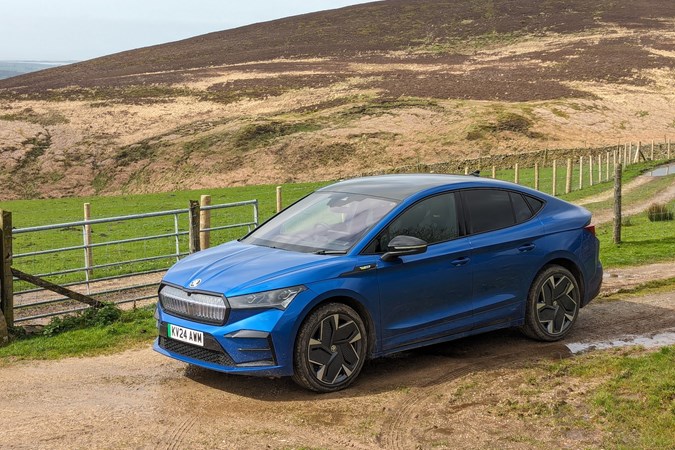
These days, I don’t plan my journeys, I just go on them. If I need to stop and recharge I do. The only thought I put into the whole process is what kind of coffee I’ll have while I wait. Don’t get me wrong, I’m incredibly lucky to have a charger at home and at the office, so I appreciate that it’s a very different story for someone living in a town or city where public charging is at a premium. But I do believe that chargers for all (or at least many) will be on the government agenda soon.
Given the Enyaq’s now been around a while, that’s all the more impressive. Spending time in the (cheaper) Parkers Car of The Year-winning Renault Scenic E-Tech has shown up one or two areas where the Skoda has dropped behind – most notably infotainment, ride comfort, driving range and brake feel. But as it’s three years younger, you’d expect that, given the current rate of progress in car design and engineering.
So, would I still recommend an Enyaq as your family car? Without a doubt. It’s roomy, simple to drive, and just gets on with it job without any fuss. I love the interior design and clever use of interior trims and colours, too. I’d probably forego the vRS, and head straight for the 80X four-wheel drive SUV version, which is almost as quick, slightly more practical, and rides just that little bit better. Otherwise, it’s still as good as ever.
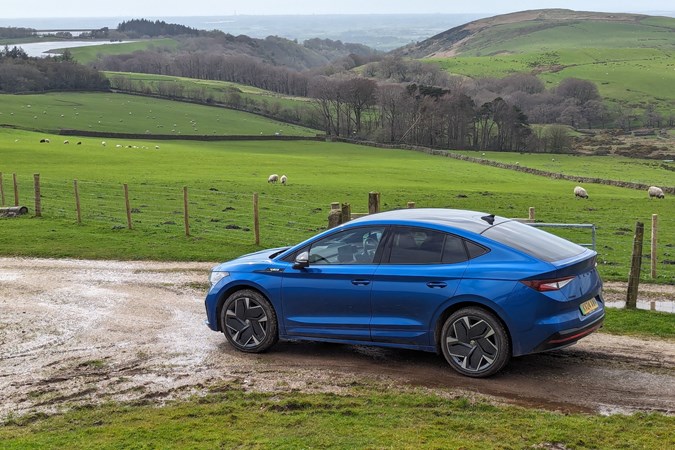
Skoda Enyaq long-term test: scores on the doors
Model tested: Coupe vRS
| Current mileage | 9,350 |
| Electrical efficiency | 3.6 miles/kWh |
| Parkers real world range | 280 miles |
| Parkers ‘MPP’ (Miles Per Pound) calculation | 5.7 – 12.6 |
| Dates tested by Parkers | April 2024 – November 2024 |



